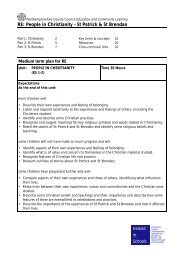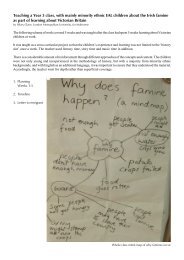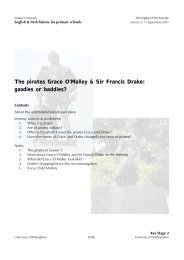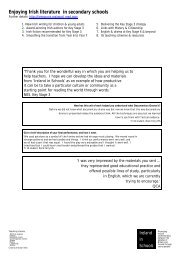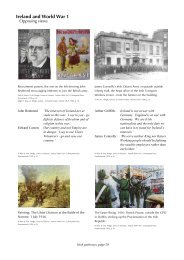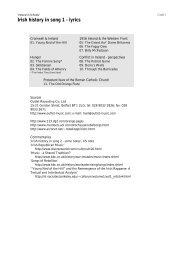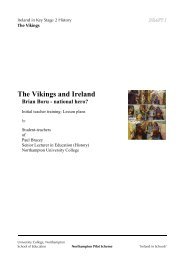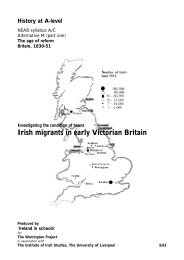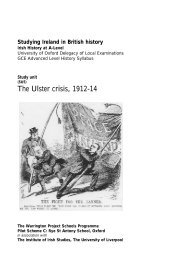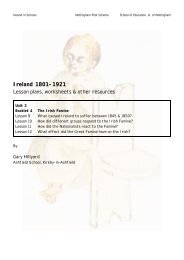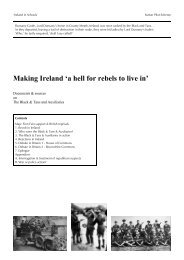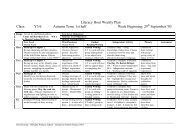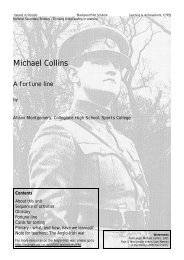New Key Stage 3 History Programme of Study A ... - Ireland in Schools
New Key Stage 3 History Programme of Study A ... - Ireland in Schools
New Key Stage 3 History Programme of Study A ... - Ireland in Schools
You also want an ePaper? Increase the reach of your titles
YUMPU automatically turns print PDFs into web optimized ePapers that Google loves.
3. <strong>Ireland</strong> & the Stuarts & CromwellA. S<strong>in</strong>gle lessons3.1. What changes did thePlantation <strong>of</strong> Ulster br<strong>in</strong>g?Nott<strong>in</strong>gham Pilot Scheme -th<strong>in</strong>k<strong>in</strong>g skills exercise3.2. Why did the Englishwant to control <strong>Ireland</strong>?Nott<strong>in</strong>gham Pilot SchemeB. <strong>Study</strong> units3.3. Reputations. Sources:Cromwell at DroghedaSomerset Pilot Scheme3.4. Cromwell <strong>in</strong> <strong>Ireland</strong>Collective memory& Audience & PurposeBlackpool Pilot Scheme -Th<strong>in</strong>k<strong>in</strong>g skills exercise3.5. Battl<strong>in</strong>g for <strong>Ireland</strong> <strong>in</strong>the 17th century: Droghedaand the BoyneNorthampton Pilot SchemePupils work<strong>in</strong>g <strong>in</strong>dividually.1. Read the extract from Lord Carew, describ<strong>in</strong>g Omagh <strong>in</strong> 1610.2. Pupils draw the map/picture <strong>of</strong> Omagh by listen<strong>in</strong>g to the description3. Suggest re-read as <strong>in</strong> a language listen<strong>in</strong>g exercise.5. Pupils work out strategy themselves-notes, bullet po<strong>in</strong>ts, rough sketches, etc.http://hometown.aol.co.uk/Iis04/Secondary_Hist_Th<strong>in</strong>k<strong>in</strong>g_Skills.pdf1. Why did the English want to conquer <strong>Ireland</strong>?2. What happened <strong>in</strong> Ulster and how did Plantation change Ulster?3. Assessment based on the organis<strong>in</strong>g question.http://hometown.aol.co.uk/KHA200/Tuxford_KS3_Y7T3_U_Plantation.pdf1. Listen to ‘Young Ned <strong>of</strong> the Hill’ by the Pogues (without the lyrics). Discuss the tone<strong>of</strong> the song. What sort <strong>of</strong> music is it? What are they say<strong>in</strong>g?2. Read through the follow<strong>in</strong>g two pages <strong>of</strong> booklet, discuss<strong>in</strong>g plantations andstudy<strong>in</strong>g the maps3. <strong>Study</strong> ‘A vicious circle’ diagram and answer the follow<strong>in</strong>g questionsa. Why did the Irish hate the English? b. Why did the English hate the Irish?4. <strong>Study</strong> the English view <strong>of</strong> the Irish Rebellion (l<strong>in</strong>k<strong>in</strong>g <strong>in</strong> with previous lesson onTrigger 2 <strong>of</strong> English Civil War):a. Describe what the picture shows. b. Decipher the ‘olde’ English at the top.5. Read Cromwell’s own report to Parliament after the events at Drogheda, andexam<strong>in</strong>e the map:a. Accord<strong>in</strong>g to Cromwell, what happened at Drogheda (bullet po<strong>in</strong>ts).b. How does Cromwell justify his actions?6. Listen to ‘Young Ned <strong>of</strong> the Hill’ aga<strong>in</strong>, this time with the lyrics:a. What do the Pogues th<strong>in</strong>k <strong>of</strong> Cromwell? b. Why do you th<strong>in</strong>k they th<strong>in</strong>k this?7. Read Antonia Fraser’s piece on the events at Drogheda. Expla<strong>in</strong> who she is, discusshow she would have obta<strong>in</strong>ed <strong>in</strong>formation, evidence etc.a. What does she say about Cromwell?b. Does she attempt to justify his actions? How? What does she say?8. Sentiments and accuracy <strong>in</strong> <strong>in</strong>terpretation:a Which <strong>of</strong> the two views <strong>of</strong> Cromwell would you trust more? Expla<strong>in</strong> <strong>in</strong> detail.b. Whose sentiments would you go along with, the Pogues’ or Antonia Fraser’s?(Some explanation <strong>of</strong> justification and sentiments may be required)http://hometown.aol.co.uk/KHA200/Cromwell_Drogheda.pdf1. Scheme <strong>of</strong> learn<strong>in</strong>g (PlanEasy2)2. WorksheetsNaked Protestants - image to be enlarged to A3 for group exerciseNaked Protestants - Image with transcription for check<strong>in</strong>g and debriefSong package, ‘Young Ned <strong>of</strong> the Hill’3. What & how have we learned?4. Notes for teachers: 1641 Ris<strong>in</strong>g; Cromwell & <strong>Ireland</strong>; Background note to ‘Ned <strong>of</strong>the Hill’http://hometown.aol.co.uk/Iis05/03_Collective_Memory_Cromwell_<strong>Ireland</strong>.pdf1. How different was <strong>Ireland</strong> <strong>in</strong> 1700 from 1500?2. Siege <strong>of</strong> Droghedaa. Look at a map to see why there was a battle at Droghedab. How easy was it to defend Drogheda?c. Were Drogheda’s strengths greater than its weaknesses?If you were Cromwell where would you attack it? In what ways was Drogheda (i)easy to defend and (ii) weak.d. The battle <strong>of</strong> Drogheda. Split <strong>in</strong>to news reporters for (I) Royalist (Irish) and (ii)Cromwell’‘s side. When your group gets a new piece <strong>of</strong> <strong>in</strong>formation you have toi. write down what it says from your sides po<strong>in</strong>t <strong>of</strong> view; andIiS, Irish <strong>History</strong> for <strong>Key</strong> <strong>Stage</strong> 3, 11



